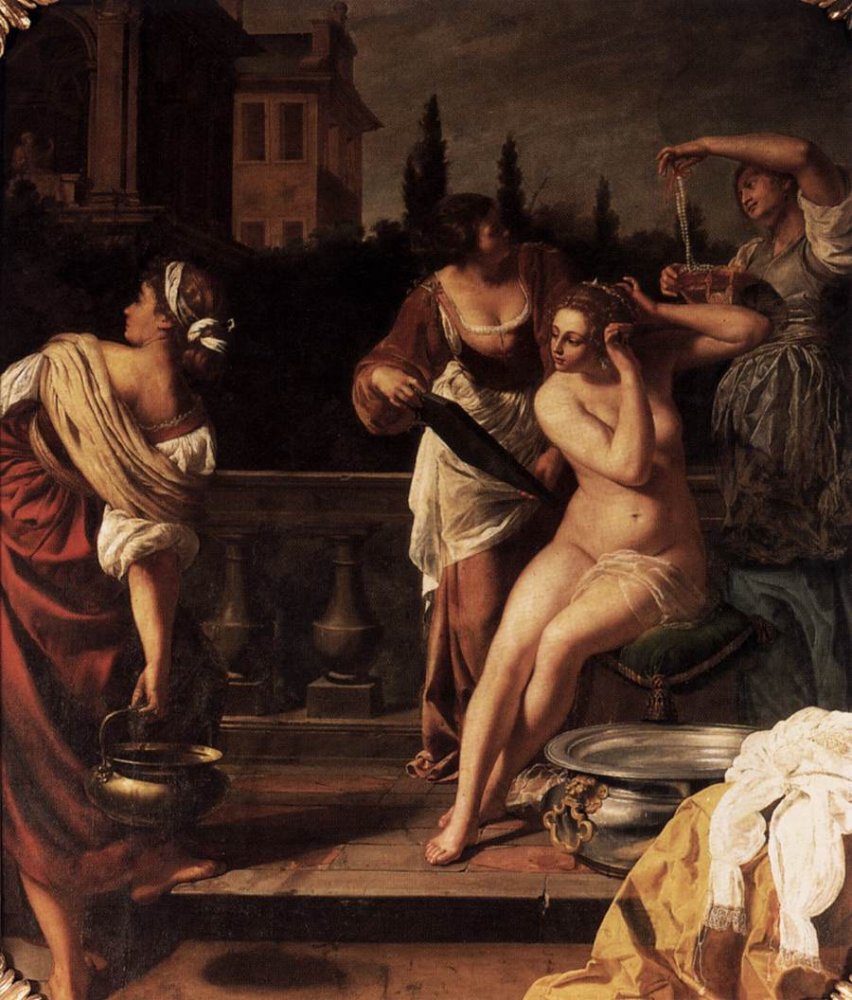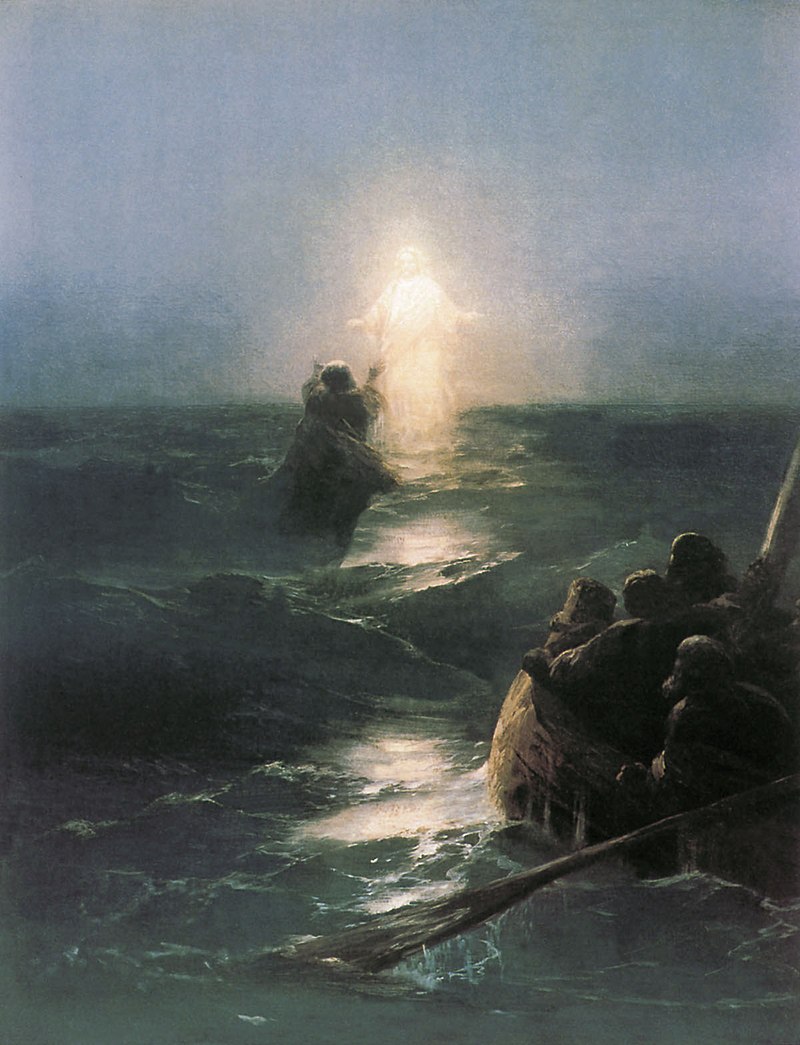
Bathsheba taking a bath – with David watching – “from his balcony (top left)…”
* * * *
The last time I posted on the Bible readings for an upcoming Sunday was for Trinity Sunday. That was May 27, nearly a month ago. (Of course it didn’t help that I was on vacation for the first two weeks of July. See A Mid-summer Travelog.)
And there’s another reason to focus on these particular passages. I’ll be the lay reader – up front with a microphone – as part of my Anglican Communion authorization “to read some parts of a service of worship.” So it’ll definitely help to know the background.
Those readings are in The Lectionary under Ninth Sunday after Pentecost – Proper 12. The Track 1 readings are 2 Samuel 11:1-15, followed by Psalm 14, then the New Testament, Ephesians 3:14-21. (The Gospel – that the priest reads – is John 6:1-21.)
2d Samuel 11:1-15 tells of David – when he was King of Israel – seeing Bathsheba, taking a bath “in the altogether,” as seen at the top of the page. It also tells what David did to Uriah the Hittite, Bathsheba’s husband. (After he – David – got her pregnant.) When Bathsheba told him about that, David had Uriah brought back from the war and tried to trick him into knowing her in the Biblical sense. (That way, Uriah would think that the kid was his.)
When that didn’t work, David basically had Uriah killed. (But he made it look like an accident.) And it was because of all this that David wrote Psalm 51, “by any measure, one of the best-known and most often read penitential texts” in the Bible. See Psalm 51 Commentary.
See also Repentance for the Soul (Psalm 51) | Bible.org:
Psalm 51 is one of seven penitential psalms. David threw himself on the mercy of God after committing adultery and murder. That’s right: King David messed up “royally.” His two-fold repentance provides a model that we should follow when we choose sin…
So anyway, 2d Samuel 11:1-15 begins: “In the spring of the year, the time when kings go out to battle, David sent Joab with his officers and all Israel with him; they ravaged the Ammonites, and besieged Rabbah. But David remained at Jerusalem.” That’s when the trouble began.
 But first, a telling detail in 2 Samuel 11:4, in parentheses: “(Now she was purifying herself from her monthly uncleanness.)” That’s another way of saying that the reason she was taking a bath in the first place was that she’d just finished her monthly period. Which means in turn that Bathsheba was required to bathe, according to Leviticus 15:19: “When a woman has her regular flow of blood, the impurity of her monthly period will last seven days…” (“Et Seq.,” including various other situations requiring one to “wash your clothes and bathe yourself in water.”) See also Ritual purification – Wikipedia.
But first, a telling detail in 2 Samuel 11:4, in parentheses: “(Now she was purifying herself from her monthly uncleanness.)” That’s another way of saying that the reason she was taking a bath in the first place was that she’d just finished her monthly period. Which means in turn that Bathsheba was required to bathe, according to Leviticus 15:19: “When a woman has her regular flow of blood, the impurity of her monthly period will last seven days…” (“Et Seq.,” including various other situations requiring one to “wash your clothes and bathe yourself in water.”) See also Ritual purification – Wikipedia.
There’s another aspect of this “telling detail.” It was the writer’s way of making sure we knew the child had to be David’s. (Without that detail some old-time spin doctor might say: “Hey! How do we know Uriah didn’t ‘know Bathsheba Biblically‘ before he left for the wars?”)
Other – related – highlights include 2d Samuel 11:8, where David brought Uriah back from the battle-front and told him, “Go down to your house, and wash your feet.” (That’s a euphemism for “Relax! Go home and have sex with your wife!” See Hebrew – How does the act of “foot washing” lead to “sexual intercourse?”) But Uriah had a problem. He was both too pure and too good a soldier. See 2d Samuel 11:9. So Uriah didn’t go home to Bathsheba and “wash his feet.” Instead he “slept that night at the palace entrance with the king’s palace guard.”
All of which may well be some kind of object lesson, but we digress…
The reading ended with David trying to get Uriah drunk again, and when that didn’t work he sent a letter to Joab, his army commander. “In the letter he wrote, ‘Set Uriah in the forefront of the hardest fighting, and then draw back from him, so that he may be struck down and die.'”
(And just a note: The Old Testament reading for next week skips over verses 16-25 of Samuel 11, and starts off with Bathsheba first hearing that her husband Uriah has been killed.)
Moving on to Psalm 14, it starts: “The fool has said in his heart, ‘There is no God.’ All are corrupt and commit abominable acts; there is none who does any good.” What follows is a “description of the depravity of human nature, and the deplorable corruption of a great part of mankind.” See Psalm 14 – Matthew Henry’s Commentary. But as usually happens, Psalm 14 ends with a note of hope: “when the LORD restores the fortunes of his people, Jacob will rejoice and Israel be glad.” (“Jacob” and “Israel” are the same person. See Genesis 32:22-32 – Jacob Wrestles With God, and also On arguing with God.)
 The New Testament lesson is Ephesians 3:14-21, written by the Apostle Paul. (Seen at right.) Mainly the letter is about “Paul’s Hopes and Prayers for the Ephesians.” This part was preceded by Paul telling about the hidden mystery that the Gentiles should be saved, and that it was to him – Paul – that grace given, that he should preach it. In verse 13, Paul had just told the Ephesians not to be discouraged over his tribulation. In this reading he prays that they may perceive the great love of Christ toward them.
The New Testament lesson is Ephesians 3:14-21, written by the Apostle Paul. (Seen at right.) Mainly the letter is about “Paul’s Hopes and Prayers for the Ephesians.” This part was preceded by Paul telling about the hidden mystery that the Gentiles should be saved, and that it was to him – Paul – that grace given, that he should preach it. In verse 13, Paul had just told the Ephesians not to be discouraged over his tribulation. In this reading he prays that they may perceive the great love of Christ toward them.
Moving on to Gospel, John 6:1-21 will be read by the priest. But as always, it pays to know something of the background of the reading beforehand.
The reading starts off with the story of Jesus feeding the multitude:
Feeding the multitude is the combined term used to refer to two separate miracles of Jesusreported in the Gospels. The first Feeding Miracle, “The Feeding of the 5,000” is the only miracle (apart from the resurrection) which is present in all four canonical Gospels: Matthew 14:13-21, Mark 6:31-44, Luke 9:10-17 and John 6:5-15. The second miracle, “The Feeding of the 4,000” with seven loaves of bread and fish is reported by Matthew 15:32-16:10 and Mark 8:1-9, but not by Luke or John.
For a non-traditional view of this miracle, see Another view of Jesus feeding the 5,000.
This part of the Gospel reading ends with the people saying that Jesus “is indeed the prophet who is to come into the world,” and trying to “take him by force to make him king.” That’s when he withdrew “to the mountain by himself.” All of which led to the last part of the Gospel reading, the story of Jesus walking on the water, toward His disciples:
The sea became rough because a strong wind was blowing. When they had rowed about three or four miles, they saw Jesus walking on the sea and coming near the boat, and they were terrified. But he said to them, “It is I; do not be afraid.”
Wikipedia noted a number of alternate, competing and/or “scientific” theories about this miracle, and it’s probably a very good idea for us to explore them all. After all, in John 14:12 Jesus did tell His followers, “whoever believes in me will do the works I have been doing, and they will do even greater things than these…” (See also “What’s in it for me?”)
Which may mean it’s high time for us to get cracking on that “mystical side of Bible reading…”

“Jesus walks on water, by Ivan Aivazovsky(1888)…”
The upper image is courtesy of David and Bathsheba – The Life and Art of Artemisia Gentileschi. The painting was done in 1650. The full caption:
Pretty Bathsheba has finished her bath. She is fixing her hair, using the mirror held by a servant… Perhaps she has already received King David’s message. David has been watching her from his balcony (top left) and asks her to pay him a visit.
Gentileschi (1593-1656) was a woman artist in an “era when women painters were not easily accepted by the artistic community or patrons.” She was the first woman to become a member of the Accademia di Arte del Disegno in Florence, and painted “many pictures of strong and suffering women from myth and the Bible – victims, suicides, warriors.”
Her best-known work is Judith Slaying Holofernes, which is pretty gruesome. It shows her decapitating Holofernes, in a “scene of horrific struggle and blood-letting.” She – Gentileschi – was raped earlier in life, which apparently wasn’t that unusual at the time. What was unusual was that she “participated in prosecuting the rapist.” For many years that incident overshadowed her achievements as an artist, and she was “regarded as a curiosity.” But today she is seen as “one of the most progressive and expressionist painters of her generation.”
The “stupendous” image is courtesy of David and Bathsheba (film) – Wikipedia, the free encyclopedia.

Re: “all that you can be.” See Slogans of the United States Army – Wikipedia, re: the recruiting slogan from 1980 to 2001. The image at left is courtesy of www.toywonders.com/productcart/pc/catalog/aw30.jpg.
* Re: “mystical.” As originally used, the term mysticism “referred to the Biblical liturgical, spiritual, and contemplative dimensions of early and medieval Christianity.” See Mysticism – Wikipedia, the free encyclopedia, and also the post On originalism.
Re: Psalm 51. For more see Psalm 51 – Wikipedia, David’s Psalms of Repentance (Psalms 51 and 32), and/or Psalm 51: A Model Of Genuine Repentance | Answers From The Book.
The image of St. Paul is courtesy of St. Paul El Greco.jpg – Wikimedia Commons.
The lower image is courtesy of Jesus walking on water – Wikipedia, the free encyclopedia.